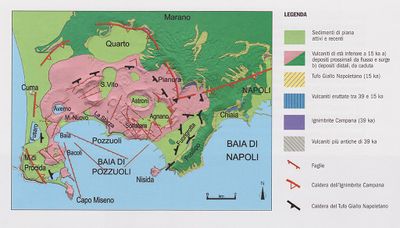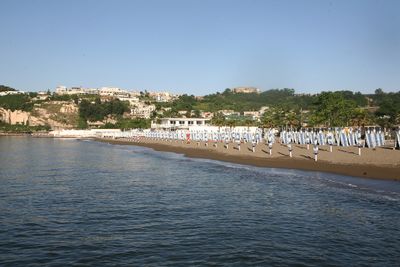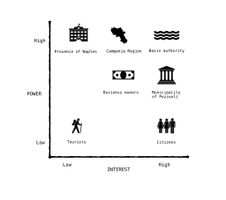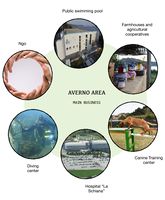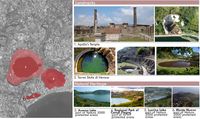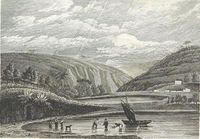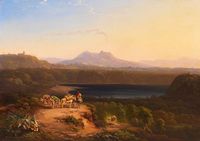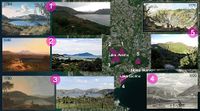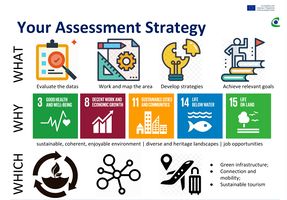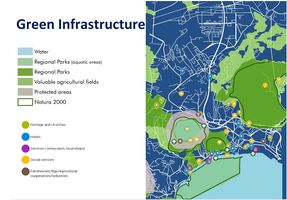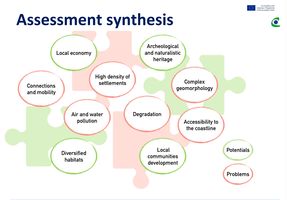Case Study C: Averno: Difference between revisions
Asif.adnan (talk | contribs) |
Asif.adnan (talk | contribs) |
||
| Line 223: | Line 223: | ||
== B.2 Mapping == | == B.2 Mapping == | ||
===Green Infrastructures=== | ===Green Infrastructures=== | ||
On our first map, we tried to map the green infrastructural areas or approaches, because green infrastructures is an important approach which aims to restore, protect or enhances the quality of natural water cycle. This will in turn protects the ecosystem and ensures the safety of the community structure. These green infrastructures have a direct impact with the existing water areas namely the Lake Averno & the Lake Lucrino. To get a detailed understanding of this, we analyzed the inter-relation among the green, blue and gray infrastructures and | On our first map, we tried to map the green infrastructural areas or approaches, because green infrastructures is an important approach which aims to restore, protect or enhances the quality of natural water cycle. This will in turn protects the ecosystem and ensures the safety of the community structure. These green infrastructures have a direct impact with the existing water areas namely the Lake Averno & the Lake Lucrino. To get a detailed understanding of this, we analyzed the inter-relation among the green, blue and gray infrastructures and as we can see, there are basically four different areas that serve the purpose. Lake Averno is surrounded by the Regoinal Park lands and it also falls under the protected zone.Towards the North-East outskirts we have mainly valuable agricultural land and towards the coast we also have coastal green zone.An important thing of these green areas can be noticed that, almost 70% of these green zones are the part of Natura 2000 which ensures the long term survival of various threatend species and habitats. To get a visual idea of the degree of local intervention in these green areas we also tried briefly to map some important infrastructures which are represented as little points of interest in our green infrastructural map. | ||
===Connections=== | ===Connections=== | ||
===Tourisms=== | ===Tourisms=== | ||
Revision as of 14:24, 8 May 2019
>>>back to working groups overview
Rationale
When looking rapidly to this area, one can notice where mystery of the location is adapting to reality, creating an extraordinary landscape. Composed of the beach, mountains, volcanic lakes and a collection of cultural heritage. Going more in depth with landscape analysis, it is realized that the complexity of the geomorphology is a challenge for the human development, due to small free areas available. This pressure caused by the human needs risks the unique vegetation in the volcanic areas, so important for the maintenance of the local ecosystem. This disturbance would affect dramatically the existing blue and green connections.
The tectonic and volcanic activities that shaped Italy are huge threats as well, once it is not possible to control them. With technology, it is possible to prevent catastrophes and human losses, but material damages are always in stake. Matters such evacuation routes and procedures, shelter, water and food in cases of natural disasters are especially important in this location.
Regarding our abilities as architects and landscape architects, it is our priority to raise awareness about the relevance of the locals as well as keep in mind the quality of life of the inhabitants, their connection with the environment and sustainability of new developments.
Location and scope
A Landscape System Analysis
A.1 Landscape layers and their system context
Geomorphology, landscape units and coastal typology
The formation of Italy as we know is the result of a series of complex sismic movements, starting from the collision between the African and European tectonic plaques. The sequence of collisions created the long chain of montains that crosses the country from south to north, the Alpenines. Smaller geografical accidents happened due to the phenomena, which, combined with the volcanic activities, led to the nowadays morphology.
In Pozzuoli, it is not different: lakes, shores and reefs tell us the evolution of the landscape. Today, both sismic and volcanic activities remain quiet, but not long ago, in the 1980's, Pozzuoli had to move around 50m ahead from its original location due to a rapid rising of the earth surface. Combined with the stress caused by populational growth, the town could a major change on its landscapes
Geomorphology Pozzuoli. Source: http://ncpcstasia.weebly.com/il-rischio-vulcanico.html
Coastal volcanic rocks. Source: https://www.repubblica.it/viaggi/2015/12/04/news/scoprire_campi_flegrei_napoli_campania-128801959/
Low coast with volcanic rocks on the background. Source: https://lidonapoli.it
Land use
The study area is mainly characterized by residential, agricultural and touristic activities.
The agriculture consists mainly of fishing, pomiculture, viticulture and greenhouses. Those are divided in different zones: fish farming on the coast and vineyards, orchards and greenhouses towards the mainland. Tourism is a present and visible activity on the coast and close to the Lake Averno and Lake Lucrino and to the natural heritage elements.
Regarding settlements, the configuration of the land (coast, volcanic cones and lakes) limits the expansion of the built area and the Averno Zone is in need of housing facilities. If the housing activities expand, the farmlands which are important to the local economy, will be endangered.
The main infrastructure consists of three main railways: the Cumana Railway, The Circumflegrea railway which is a commuter railway line that connects Naples city center with the northern Phlegraean Fields, a suburban area located west of the city and line 2 which is a commuter rail service operated by Trenitalia in the city of Naples, Italy that connects 12 stations. Also in the study area we can find the A56 highway - which cuts Pozzuoli in half(the administrative area and the colective housing on one side,and the Hospital and the individual housing on the other side of Pozzuoli). The local road sistem is permeable enough, but the public transportation that connects the Averno area with the rest of the region is made possible only by train, which is slow, resulting in a bad connection especially with Napoli.
Resource extraction is based on geothermally heated groundwater which are appealing for tourists. The Averno study area has many recreation centers based on thermal waters.
A large percentage of the study zone consists of two volcanic lakes(Averno and Lucrino) and the Regional Park of Campi Flegrei(on the Monte Nuovo volcano). The coast is highly urbanized with the presence of the railway and the touristic activities. Although he railway conects the study area with the City of Naples, on a local perspective, it acts like a physical and visual barrier between the coast and the mainland.
Energy production consists, at the scale of Campania region, mainly in electricity production from wind power which increased over tenfold from 2002 to 2015.
The study area which is a part of Campania region has many diverse activities from agriculture to housing to tourism, but without a coherent strategy the area will remain non-pedestrian friendly and with poor interconnection in a regional system regarding the public transport.
Green/blue infrastructure
The study area has strong elements of both blue and green infrastructure.
The blue elements are represented by the lakes of Averno and Lucrino, the seafront of Pozzuoli and Lucrino, the underwater archaeological reserve of Lucrino, and the Tyrrhenian Sea. Also, the entire area benefits from the geothermally heated groundwater.
The green elements are represented by the Monte Nuovo volcano (where the Regional Park of Campi Flegrei is located) a small part of the Monte Gauro, the crater of Averno, and the Lucrino Coast.
Although both green and blue elements have a strong presence in the territory, and are of high importance in the future economic development of the coast, they are undervalued (on a touristic perspective) because of the rather shallow links between them. Another issue which regards the Phlegrean coast, is represented by the level of pollution of the sea, which impacts on an ecological perspective the marine biodiversity, and on an economic perspective, the level of attractiveness of the area for tourists. (for as long as bathing on the coast is not allowed because of the sea pollution).
The proactive actions towards improving the green-blue infrastructure of the Averno region will result in an increase in ecological awareness, protection of the marine biodiversity, and in the development of the local economy.
Actors and stakeholders
Thanks to the stakeholders' analysis it is possible to outline the actors of the study area and prioritize them by power and interest. The area is part of the Municipality of Pozzuoli, one of the 92 comuni belonging to the Metropolitan City of Naples and it is the main city of the Phlegrean fields. The leading institutional actors involved are the Basin Authority, the province of Naples (Metropolitan City of Naples), Campania region and, of course, the Municipality that is responsible for more practical decisions.
In particular, the Basin Authority is an institution that operates at a national, interregional and regional level, on the catchment areas and deals with the defense of the soil and subsoil and the rehabilitation of water. The water catchment areas of the Phlegraean fields are managed by the "Regional north-western Campania Basin Authority" that has strong power in this area. The Campania Region has had a high interest in the Phlegraean area in recent years. This can be explained by several reasons, above all the proximity to the Bagnoli area, of which it should constitute the natural continuation in view of the conversion of the entire area into an area dedicated to tourism and entertainment.
Other actors involved, but with a low level of power, are the citizens that actively participate in the social and economic life of the study area. To the business owners belong a huge piece of stakeholders with a pretty strong interest in the area that can not be excluded (bars, restaurants, dog park, sports activities, spa, diving center, tourist accommodations).
The tourists could be considered as actors in this system too: they have not a particular power of decision in the development of Pozzuoli Municipality, even if they are not pretty much affected by the urban changes. Thanks to the presence of several farmhouses and agricultural cooperatives the area attracts every year a quite huge number of tourists that want to experience a rural life.
Also, the non-profit organizations have a strong social impact on the territory.
A relevant role is played by “Percorsi Cumani”, a community of people with a common priority: create a network of cycle paths extending throughout the Campi Flegrei area from Nisida to Miseno. The “Percorsi Cumani” project aims to present to the public administrators in the Naples Metropolitan area an alternative transport, more sustainable. The study area is strongly involved in this project, in particular regarding the area near the Averno lake that could be connected to Cuma thanks to the restoration of the viability of the Cocceio Cave, the historic passage carved by the Romans that connected the Averno lake to Cuma.
Sacred spaces and heritage
The study area consists of two very important landmarks: Apollo’s Temple and Terme Stufe di Nerone and also really important natural heritage elements: Lake Averno, Lake Lucrino, the Regional Park of Campi Flegrei and Monte Nuovo. The landmarks are close to the Lake Averno and Lake Lucrino and the natural heritage makes up about 40% of the study area.
The Thermae, usually called “Temple of Apollo” is found on the Eastern shore of Lake Averno and consists of two levels enriched by niches and windows, the plan is octagonal outside and circular shaped on the inside. The thermal baths at Terme Stufe di Nerone are positioned on the southern side of Lucrino Lake. The therapeutic benefits of thermal waters and the wonderful natural surroundings made the Terme Stufe di Nerone be very appealing to the citizens of ancient Rome. These thermal baths kept on improving over the years, becoming bigger up to the size that can be seen today.
Lake Averno is a roughly circular lake, measuring up to 2km in circumference and 60m in depth. This lake was of immense importance to the Romance since they believed to be the entrance to Hades. The lake used to be owned by the House of Bourbon, then by an aristocratic family who then sold it to Cardillo family. Finally the lake was seized by law enforcement in 2010. Lake Lucrino is found one km south of Lake Averno and is separated from the sea by a slim strip of land. The Lake used to be bigger but due to the cratered volcanic cone of Monte Nuovo it became smaller sincer 1538.
The Campi Flegrei Regional Park represents one of the most important parts of the region being a part of an intergrated landscape-cultural-environmental territorial system. The territory is characterized by the diverse landscape: coast, volcanic activity, thermal waters, natural ports and protected areas. Monte Nuovo is a volcanic cone that last erupted in 1528 due to damaging earthquakes and changes in land elevation. Its eruption is important because it was the first eruption described by a large number of witnesses.
Visual appearance and landscape narrative
This area, together with lake Averno and Lucrino and Monte Nuovo, is a place with many different narratives that have been embedded in the landscape throughout centuries. At first it held an importance to the Greek when it was a place with mystery, a darker undertone, it was a place of afterlife and fatality (according to the georgics of Virgil).
Then the Romans came and the building of Portus Julius started, changing the narrative from mystery to reality. The narrative was still about connecting people and places with one another, but this time it was about connecting ships with the sea and the lakes. During Roman times this place also carried a narrative of luxury and celebration with its growing architecture, thermal springs, green oysters and fish.
During centuries there has been a constant struggle between surrounding threats (like storms from the sea, earthquakes and erupting volcanoes) and creating an enjoyable haven. The geomorphology of the area is also something that is accountable for the diversity of narratives - for example change and humbleness. Since the area was and is located on the Phlegraean Fields there are changes happening in the landscape, resulting in the changes of people lives.
However after the eruption of Monte Nuovo in 1538 people started to notice the surrounding picturesque landscape and learned to embrace it through paintings and stories. Because of its vivid surroundings the area was quite popular among poets, like Vergilius, Omer, Alexandre Dumas etc. and artists, especially during the 18th-19th centuries among the Grand Tourists and landscape artists, like Pietro Fabris, Jacob Philipp Hackert, Richard Wilson, Gaspar Van Wittel etc. Nevertheless many created paintings, poems, stories and verses have an unknown author.
Looking at different paintings from 18th and 19th century one can see new narratives unfolding. On the paintings there are always people and viewpoints looking toward the sea, the lakes, and the surrounding landscape - the vulcanos, the mountains and vegetation. This kind of depicting creates a narrative of loneliness, looking out and waiting for something or someone out in the far (sea), longing to meet again. Even though these paintings might have an melancholic undertone, they are all portrayed in warm colors and sceneries. Referring to a narrative of enjoyment, where people understand and emphasize the surrounding landscape and the threats in it, and not letting it harm the haven they are living in. Comparing how the landscape is featured nowadays, one can say that the narratives of connecting, longing, enjoyment, change, danger, humbleness have been carried out to this day, and are still creating a feeling of a haven.
A.2 Summary of you landscape system analysis and your development Targets
Although there are several typologies of coastal landscape, it is known that all are more vulnerable than other environments in general. It is now widely agreed that climate change and rising sea levels can cause damage to coastal areas globally.
However, we can not forget the complexity of coastal processes and other pressures in this environment. Basic human subsistence needs such as housing, food and employment have different characteristics when compared to the same needs in other areas. Challenging geomorphology, unstable and often unproductive soils, limited economics, and intense tourism make coastal areas a sensitive place.
A.3 Theory reflection
European Landscape Convention’s general rules help us to find the most important features of our area, direct us to the goals supporting our area and help us to come up with our own strategical keywords for the following stages.
The theory is mainly reflected on United Nations Sustainable Development goals which are goals nr : 6 - 6.3, 6.6, 6.B (Clean water and Sanitation); 8 - 8.2, 8.3, 8.4, 8.5, 8.6, 8.9, 8.B (Decent work and Economic Growth); 9 - 9.1 (Industries, Innovation and Infrastructure); 10 (Reduced Inequalities); 11 (Sustainable Cities and Communities); 13(Climate Action); 14 (Life Below Water); 15 (Life On Land).
Regarding Italian documents, the National Landscape Charter (Carta Nazionale del Paesaggio) holds three important key points: to promote new strategies to govern the complexity of the landscape; promote education and training in culture and landscape knowledge; protecting and enhancing the landscape as an instrument of cohesion, legality, sustainable development and well-being, including economic development. Our priority would be focalizing on the point 2: “The landscape represents the most extensive and complete part of the cultural heritage: the landscape is culture.” [...] “Educating to the landscape means strengthening the identity and sense of belonging of the community so that it recognizes the value of the extraordinary collective heritage of our country and actively works for its protection. Awareness and involvement are essential for safeguarding the common goods and the recognition of a collective responsibility is fundamental to prevent the degradation of urban, rural and natural contexts, to protect the historical and artistic heritage and to stem the hydrogeological risk of a fragile territory like the Italian one.”
The overall idea would be :
- to keep and emphasize the existing cultural heritage,
- the nature of the area (coast, terrain, vegetation, lakes, inhabitants etc.);
- to reduce pollution and improve water quality;
- to create better and sustainable connections (routes, paths, lanes for non-motorized and motorized traffic);
- to make people more aware about the area of Averno (educating the locals and tourists about the nature, heritage, climate and how to keep it sustainable).
To conclude, all of the mentioned keywords create an important standing point for the area’s development. Enhancing these keywords, the place becomes alive. It becomes more popular among tourists who are interested in the cultural heritage and the nature (so called ´´slow tourism´´ for the people that are interested in rural life, fresh produce and getting the real Italian countryside experience), which creates the need for small and local businesses etc, creating job opportunities for all the locals living in the area. For the locals and tourist to have a better flowing mode we need to reduce the pollution of water, create better sustainable connections between the areas, the people and the coast.
A.4 References
- AUCELLI, P., et al., Coastal landscape evolution of Naples (Southern Italy) since the Roman period from archaeological and geomorphological data at Palazzo degli Spiriti site, Quaternary International (2017), https://doi.org/10.1016/j.quaint.2017.12.040
- EMBLETON, C.; EMBLETON-HAMANN, C. (editors) Geomorphological Hazards of Europe. Elsevier. Amsterdan, 1997. https://books.google.de/books?isbn=0080532489
- LINS-DE-BARROS, F. M. Análise integrada da vulnerabilidade costeira e dos riscos associados. Conference paper, presented at VI Congresso em Planejamento e Gestão das Zonas Costeiras em Países de Expressão Portuguesa, At Cabo Verde, 2011. https://www.researchgate.net/publication/273656524_ANALISE_INTEGRADA_DA_VULNERABILIDADE_COSTEIRA_E_DOS_RISCOS_ASSOCIADOS
- SOLDATI, M.; MARCHETTI, M. (editors) Landscapes and Landforms of Italy. Springer International Publishing. Switzerland, 2017. https://books.google.de/books?isbn=3319261940
- https://en.wikipedia.org/wiki/Naples#Geography
- http://www.glaciologia.it/wp-content/uploads/FullText/full_text_22_1/08_GFDQ_22_1_Milia_73_78.pdf
- https://www.tandfonline.com/doi/full/10.1080/17445647.2017.1300611
- https://en.wikipedia.org/wiki/Lake_Avernus
- https://it.wikipedia.org/wiki/Pozzuoli
- https://www.researchgate.net/profile/Jose_Marengo/publication/317351229_Impacto_vulnerabilidade_e_adaptacao_das_cidades_costeiras_brasileiras_as_mudancas_climaticas_Relatorio_Especial_do_Painel_Brasileiro_de_Mudancas_Climaticas/links/5935ca2ea6fdcc89e708dc36/Impacto-vulnerabilidade-e-adaptacao-das-cidades-costeiras-brasileiras-as-mudancas-climaticas-Relatorio-Especial-do-Painel-Brasileiro-de-Mudancas-Climaticas.pdf
- http://seer.cgee.org.br/index.php/parcerias_estrategicas/article/viewFile/325/319
- http://www.percorsicumani.it/progetto-percorsi-cumani/
- https://www.slowfood.it/chi-siamo/che-cosa-facciamo/
- http://www.ilgiardinodellorco.it/
- https://www.fondoambiente.it/news/la-carta-nazionale-del-paesaggio
- https://s3-eu-west-1.amazonaws.com/fai-internal/document/Carta+nazionale+del+paesaggio_MiBACT+Osservatorio+nazionale+paesaggio.pdf
- https://www.coe.int/en/web/landscape
Phase B: Landscape Evaluation and Assessment
B.1 Assessment Strategy
Our goal is to evaluate, work through and map the area according to our previous strategy, find out the problems concerning the population, environment and the special landscape, making our design relevant and helpful for the local population.
We aim to have a developing, sustainable, coherent and enjoyable environment, that emphasizes the importance of sustaining the nature and heritage, which is made possible by creating/offering different systems into the landscapes( main idea is to create different connections: between natural areas for the inhabitants and the people, tourism and the area over all, etc).
We understand that such a delicate landscape needs to be preserved, but also provide good quality of life for its population. Therefore, we believe that combining cultural and natural preservation with tourism can benefit both the inhabitants and the environment. Said that, we have mapped the green infrastucture - its particularities and potentially attractive areas, the connections - mobility and distances to the points of interest and Tourism - considering the most important leisure areas in every field of interest, from roman ruins to local gastronomy.
B.2 Mapping
Green Infrastructures
On our first map, we tried to map the green infrastructural areas or approaches, because green infrastructures is an important approach which aims to restore, protect or enhances the quality of natural water cycle. This will in turn protects the ecosystem and ensures the safety of the community structure. These green infrastructures have a direct impact with the existing water areas namely the Lake Averno & the Lake Lucrino. To get a detailed understanding of this, we analyzed the inter-relation among the green, blue and gray infrastructures and as we can see, there are basically four different areas that serve the purpose. Lake Averno is surrounded by the Regoinal Park lands and it also falls under the protected zone.Towards the North-East outskirts we have mainly valuable agricultural land and towards the coast we also have coastal green zone.An important thing of these green areas can be noticed that, almost 70% of these green zones are the part of Natura 2000 which ensures the long term survival of various threatend species and habitats. To get a visual idea of the degree of local intervention in these green areas we also tried briefly to map some important infrastructures which are represented as little points of interest in our green infrastructural map.
Connections
Tourisms
- As defined by your assessment strategy you conduct the mapping and present your findings here
- As a minimum, at least three different themes need to be mapped, you may choose more if needed
B.3 Problem definition and priority setting
- Give a summary of the major findings of your mapping process, what are the problems/potentials identified?
- Draw a problems/potentials map
- Set priorities for the most relevant issues
B.4 Theory reflection
- Please reflect the assessment and evaluation methods used based on at least three readings
- Did you encounter limitations'
- 200 words test contribution
B.5 References
- give a full list of the references you have used for this section
Phase C – Strategy and Master Plan
C.1 Goal Setting
- Define strategic planning objectives based on the evaluation findings
- Link back to your original targets from section one and the Development Goals
- 150 words text contribution
C.2 Spatial Strategy and Transect
- translate your strategic goals into a vision
- develop a spatial translation of your vision
- exemplify your vision in the form of a transect with concrete interventions
- add map(s) and visualizations
- Your case spatial translaton vision.jpg
add caption here
- Your case transect.jpg
add caption here
- Your case transect detail1.jpg
add caption here
- Your case transect detail2.jpg
add caption here
C.3 From Theory of Change to Implementation
- For implementing your vision: Which partnerships are needed? Which governance model is required?
- Who needs to act and how? Draw and explain a change/process model/timeline
- Which resources are needed? On which assets can you build?
- add 150 words text and visuals
- Your case spatial your governance model.jpg
add caption here
- Your case spatial your process model.jpg
add caption here
C.4 References
- give a full list of the references you have used for this section
D. Process Reflection
- Reflect in your intercultural and interdisciplinary team on the outcomes of your study
- Which limitations were you facing?
- What have you learnt from each other?
- What would you do differently next time?
- You can also use diagrams/visuals
- 250 words text

